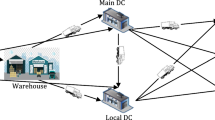Abstract
The performance analysis of supply chain is a very complicated problem. The network DEA can be used to calculate efficiency of decision-making units with multiple stages. In this paper, a new network DEA model is proposed. This model includes undesired outputs and dual-role factors. It can calculate optimistic and pessimistic efficiency. The supply chain can be ranked in terms of the overall efficiency scores. A case study is presented to demonstrate the applicability of our model.



Similar content being viewed by others
References
Badiezadeh T, Saen RF, Samavati T (2017) Assessing sustainability of supply chains by double frontier network DEA: a big data approach. Comput Oper Res 6:1–7
Beasley J (1995) Determining teaching and research efficiencies. J Oper Res Soc 46(4):441–452
Chang YT, Park H, Zou B, Nabin K (2016) Passenger facility charge vs. airport improvement program funds: a dynamic network DEA analysis for U.S. airport financing. Transp Res E 88:76–93
Charnes A, Cooper WW, Rhodes E (1978) Measuring the efficiency of the decision making units. Eur J Oper Res 2(6):429–444
Cook WD, Green RH, Zhu J (2006) Dual-role factors in data envelopment analysis. IIE Trans 38(2):105–115
Cook WD, Zhu J, Bi G, Yang F (2010) Network DEA: additive efficiency decomposition. Eur J Oper Res 207(2):1122–1129
Cooper WW, Seiford LM, Tone K (2007) Data envelopment analysis: a comprehensive text with models, applications, references and DEA-solver software. Springer, New York
Dimitris KD, Gregory K, Dimitris S (2016) The “weak-link” approach to network DEA for two-stage processes. Eur J Oper Res 254:481–492
Dimitris KD, Dimitris S, Gregory K (2016) A network DEA approach for series multi-stage processes. Omega 61:35–48
Fare R, Grosskopf S (2000) Network DEA. Socio-economic planning. Science 34(1):35–49
Farzipoor SR (2011) A decision model for selecting third-party reverse logistics providers in the presence of both dual-role factors and imprecise data. Asia Pac J Oper Res 28(2):239–254
Guo C, Roohollah AS, Ali AF, Joe Z (2017) Decomposition weights and overall efficiency in two-stage additive network DEA. Eur J Oper Res 257:896–906
Hirofumi F, Roman M (2017) Modelling bank performance: a network DEA approach. Eur J Oper Res 259:721–732
Jahanshahloo GR, Hosseinzadeh LF, Shoja N, Tohidi G, Razavyan S (2005) Undesirable inputs and outputs in DEA models. Appl Math Comput 169(2):917–925
Kao C, Hwang SN (2010) Efficiency measurement for network systems: IT impact on firm performance. Decis Support Syst 48(3):437–446
Lewis HF, Sexton TR (2004) Network DEA: efficiency analysis of organizations with complex internal structure. Comput Oper Res 31(9):1365–1410
Li X, Lo HK (2014) An energy-efficient scheduling and speed control approach for metro rail operations. Transp Res B 64:73–89
Li X, Zhou JD, Zhao XD (2016) Travel itinerary problem. Transp Res B 91:332–343
Li YL, Luo P, Fan ZP, Chen K, Liu JG (2017) A utility-based link prediction method in social networks. Eur J Oper Res 260:693–705
Li YL, Zhang D, Luo P, Jiang JY (2017) Interpreting the formation of coauthor networks via utility analysis. Inf Process Manag 53:624–639
Ma J, Qi L, Deng L (2017) Efficiency measurement and decomposition in hybrid two-stage DEA with additional inputs. Expert Syst Appl 79:348–357
Mirhedayatian SM, Azadi M, Saenv RF (2014) A novel network data envelopment analysis model for evaluating green supply chain management. Int J Prod Econ 147:544–554
Peter W, Andrew M, Rangan G (2017) Merger and acquisitions in South African banking: a network DEA model. Res Int Bus Finance 41:362–376
Seiford LM, Zhu J (2004) Modeling undesirable factors in efficiency evaluation. Eur J Oper Res 157(1):242–245
Shephard RW, Fare R (1980) Dynamic theory of production correspondences. Verlag Anton, Hain, Meisenheim
Wang YM, Chin KS (2009) A new approach for the selection of advanced manufacturing technologies: DEA with double frontiers. Int J Prod Res 47(23):6663–6679
Wang YM, Chin KS, Yang JB (2007) Measuring the performances of decision making units using geometric average efficiency. J Oper Res Soc 58(7):929–937
Xu XF, Zhang W, Li N (2015) A bi-level programming model of resource matching for collaborative logistics network in supply uncertainty environmen. J Franklin Inst 352:3873–3884
Xu XF, Hao J, Deng YR, Wang Y (2017) Design optimization of resource combination for collaborative logistics network under uncertainty. Appl Soft Comput 560(7):684–691
Yang C, Liu HM (2012) Managerial efficiency in Taiwan bank branches: a network DEA. Econ Model 29(2):450–461
Funding
This study was funded by the National Natural Science Foundation of China (71403066; 71774036; 71601087); National Social Science Foundation of China (14AGL004; 16BJY078); the Special Foundation of Central Universities Basic Research Fee (HEUCFW170907, HEUCF170903).
Author information
Authors and Affiliations
Corresponding author
Ethics declarations
Conflict of interest
Author Yi Su declares that he has no conflict of interest. Author Wei Sun declares that she has no conflict of interest.
Ethical approval
This article does not contain any studies with human participants or animals performed by any of the authors.
Informed consent
Informed consent was obtained from all individual participants included in the study.
Additional information
Communicated by X. Li.
Publisher's Note
Springer Nature remains neutral with regard to jurisdictional claims in published maps and institutional affiliations.
Rights and permissions
About this article
Cite this article
Su, Y., Sun, W. Sustainability evaluation of the supply chain with undesired outputs and dual-role factors based on double frontier network DEA. Soft Comput 22, 5525–5533 (2018). https://doi.org/10.1007/s00500-018-3240-8
Published:
Issue Date:
DOI: https://doi.org/10.1007/s00500-018-3240-8




